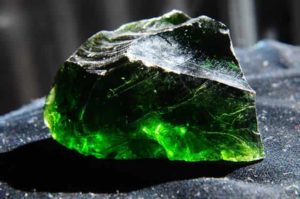
What is Green Obsidian?
Green Obsidian is one of Obsidian Rocks that contain impurities as Pure obsidian usually appears to be dark, although the color may vary depending on the presence of impurities. Iron and other elements of transition can give a dark brown to black color to the obsidian. Most black obsidians contain magnetite, an iron oxide, nanoinclusions, the composition of obsidian is extremely felsic. Obsidian mainly consists of SiO2 (silicon dioxide), usually 70% or more. Crystalline rocks comprise granite and rhyolite with the composition of obsidian.
Obsidian
Obsidian is a natural volcanic glass that is formed as an igneous rock that is extrusive.
Obsidian is produced by rapidly cooling felsic lava extruded from a volcano with minimal growth in crystals. It is commonly found within the margins of rhyolitic lava flows known as obsidian flows, where the chemical composition (high silica content) gives rise to a high viscosity that forms a natural lava glass after rapid cooling.
Obsidian is mineral-like, but not a real mineral because it is not crystalline as a glass ; moreover, its composition is too variable to be classified as a mineral. It’s classified as a mineraloid sometimes.
Obsidian Properties
- Varieties: Apache Tears, Fire Obsidian, Mahogany Obsidian, Rainbow Obsidian, Sheen Obsidian, Snowflake Obsidian
- Colors: Black; gray, banded with brown streaks. Iridescence noted: gold, silver, blue, violet, green, and combinations of these colors, due to inclusions of minute bubbles that reflect light.
- Luster: Vitreous.
- Polish Luster: Vitreous.
- Hardness: 5; 6 for basalt glass.
- Wearability: Poor
- Optics: Isotropic.
Where can obsidian be found in the United States?
- Oregon: varieties of fire, mahogany, and rainbow are known.
- Wyoming: at Yellowstone National Park in particular.
- New Mexico: Apache tears.
- Arizona
- Colorado
- California
- Nevada
- Utah: major source of snowflake variety.
- Hawaii: Pele’s hair and other varieties










